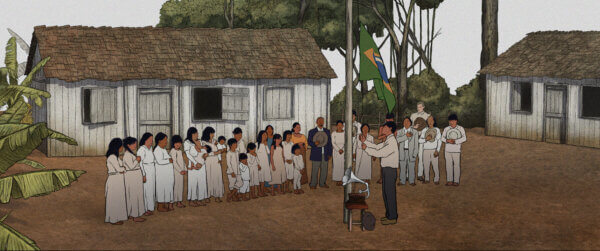ANNECY 2025: Nimeundajú Review
Nimuendajú’s greatest victory is finding an interesting use for the biopic. Outside of a select few, this genre of film is a tired practice, echoing hollow sentiments about famous people and rushing through their lives without giving you a real sense for who they were at any particular time. Nimuendajú does everything right, focusing on a period of time and questioning the moral implications of the protagonist’s actions. Its analysis of its subject isn’t as thorough as one might hope, but it’s a step in the right direction for animation, showing once again how adept it is at carrying heavy subject matter.
What helps Nimuendajú feel a bit more free within the biopic format is the fact that its subject, Curt Unckel (later known as Curt Nimuendajú) was not a famous actor or musician but an anthropologist. His work centred around studying the lives of indigenous people in Brazil and going on to advocate for their existence at a time where they were being systematically exterminated. This immediately brings up some thorny issues. Is the act of an outsider studying a culture inherently dehumanising? Is a white man the right person to centre this story around? Had Unckel’s work not enabled him to profit off the trauma of indigenous people?
Commendably, director Tânia Anaya doesn’t shy away from these questions and actively asks the viewer to engage with them. Towards the end of the film we see a range of museum exhibits dedicated to Unckel’s work in many cities across Europe. As we cross into Germany, we see a Nazi soldier admiring it, and the dissonance between Unckel’s well-meaning goals and the reality of how his work will be seen is highlighted. However, this being the only real moment of self-reflection for Unckel makes the film feel like it’s selling you short on the questions it invites you to ask. Much of the film is educational and gives you a depiction of history while highlighting the travesties suffered by indigenous people. Keeping the audience informed is great, but in 2025 we need something more substantive for it to really add to the conversation.
History isn’t always as woke as us, it doesn’t always platform the greatest people. Sometimes important work is done by a white man, and that piece of history has to be told through his eyes. Still, I think the film could do more to give its indigenous characters more agency and add more richness to the narrative.
Nimuendajú ultimately has a positive view on Unckel, seeing him as an advocate for indigenous people and constantly highlighting the lengths he went to embed himself in their culture and try to protect them. The extent to which the film reaches a satisfying balance between Unckel’s greatness and his inadvertent wrongdoings will vary depending on the viewer. The film undoubtedly would be more interesting if it was more actively interrogating that dichotomy.
One thing the movie absolutely nails is its art direction. Rotoscoping, when done poorly, can really highlight the unnatural way we’re used to animated characters moving. When watching Nimuendajú, it barely crosses your mind that it’s rotoscoped. You just fully believe in the characters in front of you, their movements never feeling too smooth or too jagged and their faces maintaining a natural look that’s always easy to read, something rotoscoped characters don’t always have.
The background art is the real star of the show. With much of the movie taking place in different parts of the Amazon, there’s ample opportunity for every shade of green in existence to be feasted on. The movie doesn’t work without the rainforest looking this good, without it inviting you in and immersing you in its sensory environment. Nimuendajú’s visuals sell you on the peace and joy that these people are fighting to keep, adding a more personal touch to the film and lessens the feeling that Unckel is exploiting this place, but truly loves it.
We need more movies like Nimuendajú to exist in animation. Only by building upon movies like this can we get to more interesting places and push the conversation about colonisation and indigenous cultures forward. It feels like there’s a lot of pressure on Nimuendajú to answer every question because how many animated movies do we get on this topic? Something that’s not talking down to its audience but is trying to get people to engage with a knotty moral dilemma? There aren’t enough. Nimuendajú pushes the medium forward, I’m excited to see where it takes it.



